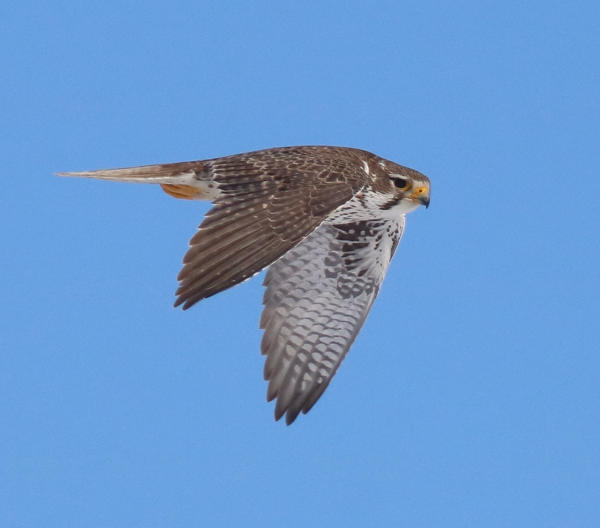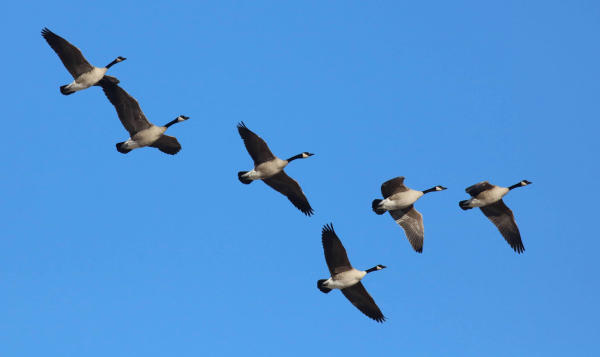
Prairie Falcon

Canada Geese
|
Peter Stangel started this week’s conversation, sharing: Canada Geese provided an auditory highlight this week. During a morning dog walk, my wife and I heard a flock of Canadas. These are wild non-migratory geese. The flock of about 25 geese was low – low enough that both dogs locked on to them as they flew right toward us. We stopped so we could enjoy the show. When the geese were about 200 yards away, we heard a second flock flying off to the side, hidden by trees.
The flock we were watching veered toward to new flock, honking loudly. As these birds passed out of sight behind the pines that line the road, we heard the two flocks coming together. Their honking increased in volume, pitch and frequency. We couldn’t see anything, but we were treated to a wave of bird sound. After five or six seconds the honking returned to a more normal level as the merged flock moved off into the distance. The whole experience lasted only about 60 seconds, but it left us both with smiles and chills. One pleasure of birding is how such short encounters can be so memorable.
With a big smile, Paul Konrad added: After some relatively quiet birding days, things changed on many fronts Wednesday. It seemed to begin when a wave of Yellow Warblers worked through my yard, searching for small insects tree by tree. They were obviously new post-nesting migrants considering I haven’t seen Yellow Warblers here since the end of May (spring migration). During my late afternoon birding drive, I found more Yellow Warblers in about half of the groves of trees I checked south of town – very exciting.
Wednesday, I also had my first post-nesting female and an immature Ruby-throated Hummingbirds visit my feeder, along with at least two males. Same day, the oriole action blew up: I had as many as four female and immature Baltimore Orioles at a time at my feeder, along with a rare sighting of an adult male; plus the usual three Orchard Orioles. New Baltimores continued to visit during the following days, indicating a full-blown oriole migration that I may have short-stopped for a while with grape jelly. Also, at least two fledgling Orchard Orioles accompanied the male to the jelly feeder and quickly adjusted to visiting the feeding station on their own or in tandem. Thankfully, the oriole parade outside my bay windows continued throughout the week.
During my Wednesday field trip, I found a large flock of Orchard Orioles – I’d say more than 20, mostly immatures or females, that flushed from a wetland shore, flew to some low willows, then uphill to a hayfield where they began feeding on insects in the company of Eastern and Western Kingbirds; and there were a few Yellow Warblers mixed in the loose flock. This hayfield has continued to be a magnet for Orchards and kingbirds throughout the week. Monday, I found similar mixed species flock (minus the warblers) in a thick stand of chokecherries and wild plums that may have included more than 30 immature and female Orchard Orioles and one male. This apparent staging of orioles will be very interesting to monitor.
Rounding out the apparent Wednesday migration, a highlight of that afternoon’s birding drive was a Prairie Falcon sighted along the Lost Road. Prairies are very rare in this region, and I’ve never seen one at that signature area before. And now that I mention falcons, I had an incidental sighting of a male Merlin flying low overhead as I stepped out of the grocery store Tuesday. You never know what will happen next when you’re a birder.
As for monitoring the fledgling hawks, on Wednesday I watched one of the three fledgling Red-tails I’ve been monitoring make a diving flight from a branch to the ground, then seemingly grab a small animal. There are many frogs in the grass, and I thought it may have caught one, but when it began to feed, it only took two bites and flew to another perch – perhaps it was a big insect. It was interesting to note that the fledglings usually have a full crop, but not Wednesday, and they are more likely to hunt if hungry. Is it possible the adults are withholding some food to promote hunting now that the fledglings are able fliers and beginning to hunt on their own?
On Saturday, I observed a Red-tail fledgling one-third mile from the nest where it was hunting from a low perch and on the ground. I also witnessed a pair of Eastern Kingbirds harass another of the fledglings intensely, forcing it to take flight and fly in a quarter-mile circle during which the kingbirds relentlessly dived on the hawk, forcing it to swerve and dip, and ending with one kingbird riding on the hawk’s shoulders over and over again as if competing in an aerial rodeo. This happens often with hawks in this area, but this episode was the most intense I’ve seen, although it did give me another look at the much improved flight capabilities of the fledgling.
I have only seen one fledgling Ferruginous Hawk during the past week, but I see one or the other adult perched a distance from the nest about every other day. I have searched an expansive area for the fledglings daily, but considering last year’s fledglings stayed in the area about six weeks, I’m sure they will be more obvious again soon. So it’s been another exciting week close to home.
Photographs by Paul Konrad
Peter Stangel and Paul Konrad are the editors of The Birding Wire and can be reached at editorstbw2@gmail.com